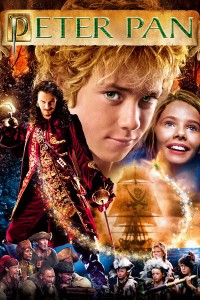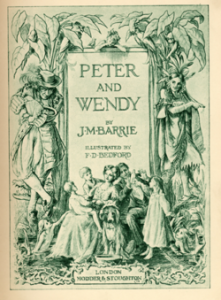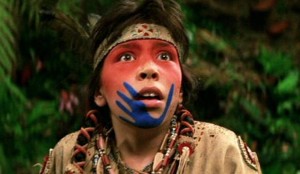by Hendley Badcock
J. Hogan’s 2003 film Peter Pan is my favorite version of the classic fairy tale, although Steven Spielberg’s 1991 film Hook is a close second. Maybe you prefer the original 1953 Disney movie or one of its sequels. Or the 2004 film Finding Neverland or Pan, which came out just last year. Or you could be a traditionalist and just really prefer J. M. Barrie’s Peter and Wendy. Regardless, we certainly are not short of options when it comes to enjoying the story.
Fairy tales like Peter Pan have survived not only through their abstract adventures and supernatural characters, but also through their narrative lessons and social commentary that both children and adults can grasp. Entertainment lies just at the surface of a timeless fairy tale. Tolkien writes that “a ‘fairy-story’ is one that touches on or uses Faërie [a fantasy realm which humans can experience], whatever its own main purpose may be: satire, adventure, morality, fantasy.”[i] Modern writers continue to modify or extend the narrative of fairytales to better analyze or critique their current culture.
Barrie’s Peter and Wendy has replanted itself in the cultures of every generation since its first on-stage production in 1904 and its publication as a novel in 1911. Literary critics speculate why we’ve held on so closely to Peter Pan and its exciting, mysterious, alluring fantasy world of flying across the stars and fighting pirates. Allison B. Kavey and Lester D. Friedman attribute its endurance to its unique genre, “one that is originally written for children, but not primarily read by adults and absorbed by children through other media, such as films.”[ii] They cite Peter Pan as an alter-reality for twenty-first century men and women’s desire to stay young and beautiful and to escape the constant demands and responsibilities crowding our schedules.
The above-mentioned films have all tweaked the story or perspective of Peter Pan in some way, but one of the most interesting renditions I’ve come across since I’ve been in college seems a bit like fan fiction but is writing with a biting, witty tongue. In her 2013 chapbook Darling Hands, Darling Tongue, poet Sally Rosen Kindred argues that women suffer from oppressive binds of traditional Victorian and Edwardian gender stereotypes in Barrie’s Peter and Wendy. She comments on the original work’s sexism by recasting the story’s largely unheard female characters of Tinker Bell, Wendy, and Tiger Lily as the focus of her verse.
In “Tiger Lily Leaves the Book for Now,” Kindred assigns angry and smart speech for the extremely self-aware American Indian princess. Tiger Lily, is the least active or vocal of Barrie’s women. Although Tiger Lily assumes command over her father’s tribe on Neverland, the princess embodies a paradox of power and passivity in both her femininity and ethnicity. She’s portrayed as an erotic, exotic parody to Peter and the Lost Boys. Be mindful that the British Empire was rising to the height of its global spread in the early 1900s.
Disturbed by Barrie’s racist and sexist portrayal of the girl, Kindred’s Tiger Lily lives in the present and embodies modernist ideals more so than any of the other characters in verse:
If my mouth were a place
the plot came aground, found
sand, found words rounded like wet stones
and teeth,
if my arms 5
held bones demanding description
and each bone were a song
or a weapon,
if my fists were full of opals
I’d keep reading. 10
If my lips moved in this story
we could talk.
I’ve shut your book. Just think
if my sisters and brothers were more
than a smudge on the page, than Redskins 15
moving in tandem, marching
in some dim
ellipse, waiting to be elected
for salvation
or the Superbowl. 20
Imagine me, waking: the chapter’s
light defined
by my lids swinging wide.
I want to be specific, arch my left
brow, my story 25
all linguistics
and technology. I want to be so ugly
you can’t look. I want a family
but you’ve given me a beer in the cheap seats.
Make me a crazed spiral, 30
nautilus scrawling
Newton’s laws in the sand. Or a girl, fine,
and American, I’ll do it still:
all I need’s something to write with,
a quarter or a cigarette. 35
I’ve thrown down your book.
Bend or kneel to find it. Open it
back up, light your fervent candles.
I’m the patron saint of getting out of here.
Tiger Lily, who never speaks in Barrie’s original work, here speaks in the first person and addresses the original author directly, assertively telling him that she has “shut” and “thrown down” his book (24-25). She makes a deal with the author—“if [her] mouth were a place the plot came aground,” “if [her] arms held bones demanding description,” “if [her] fists were full of opals,” “if [her] lips moved in this story” (24). Given the same attention and authority as other characters, Tiger Lily would be willing to reconsider her rejecting Barrie and Peter Pan. She indeed shows signs of agency and ambition, as she prefers to construct with her mouth and eyes an alternative plot.
Tiger Lily is also intelligent and crafty, appealing to her male oppressors with language they might understand—the language of professional football. But she also mentions physics as she alludes to “scrawling Newton’s laws in the sand” (25). After all, the third law of motion is all about action and reaction and Kindred is responding to Barrie. Additionally, she knows what she wants—“to be so ugly [he] can’t look,” as well as to have a family (24). The former resists any sexual objectification that was present in the novel. The latter cannot be bought from her with “beer in the cheap seats” (24). It is clear Kindred’s Tiger Lily will not settle for any nonsense and nothing less than she deserves.
Kindred could not see Tiger Lily sustaining Barrie’s time period and thus created an agentic, decisive, and serious young woman who demands equality and respect. But, writing with a new perspective and current society in mind, Kindred successfully extends the story of the trapped and voiceless women of Peter Pan and challenges our repeated acceptance of a one-hundred-year-old plot.
[i] Tolkien , J. R. R. . “On Fairy-Stories.” Trans. Array Tree and Leaf. George Allen and Unwin, 1964. Web. 10 Mar. 2014.
[ii] Kavey, Allison B., and Lester D. Friedman. Second Star to the Right: Peter Pan in the Popular Imagination . Rutgers University Press, 2008. Print.



